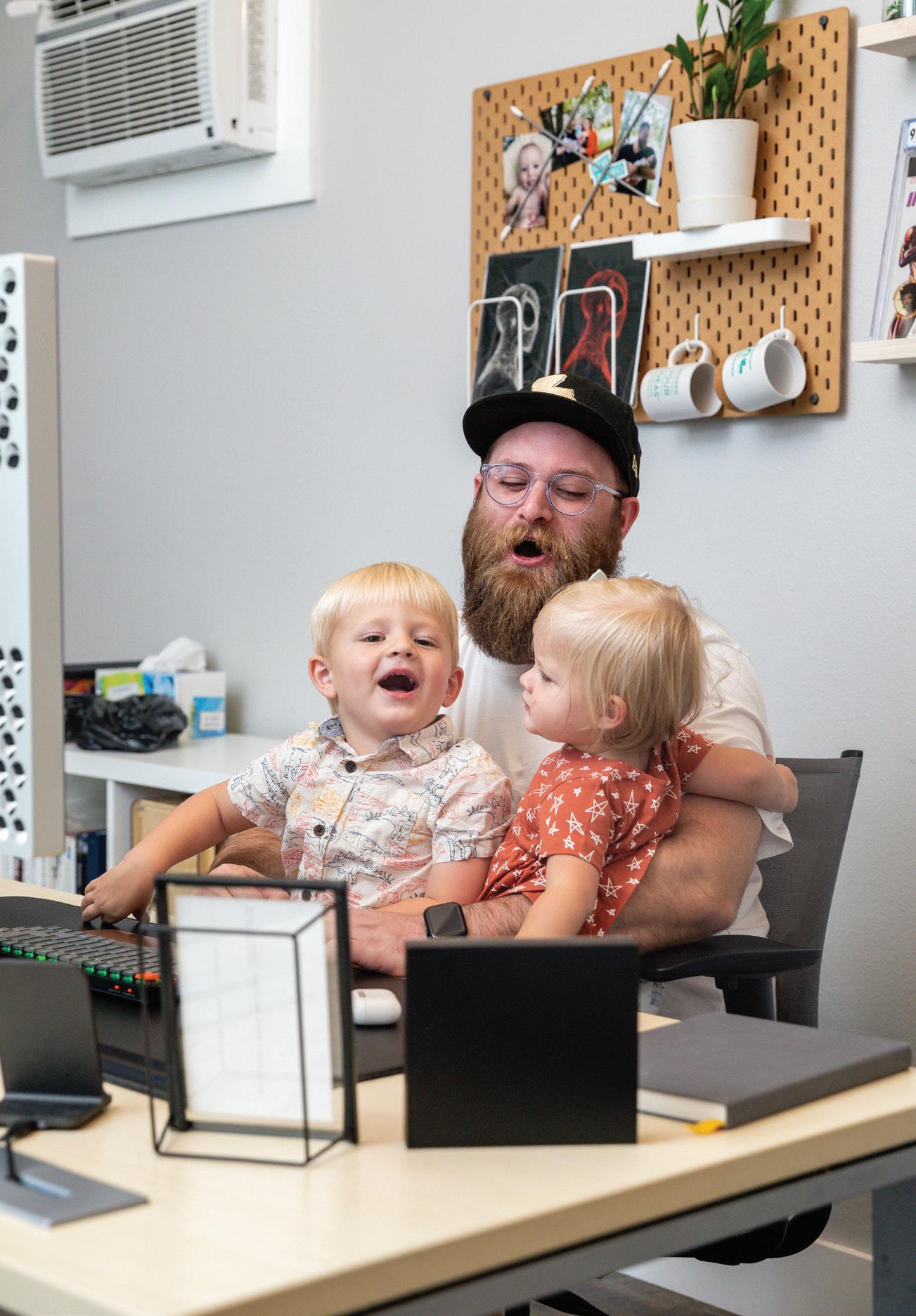
7 minute read
Balancing act
It’s proving tough to set boundaries and get away from the job when working from home. BY CHELSEA BRASTED
WHEN JENNIFER VANCE started a new job as a book publicist and digital strategist in the summer of 2019, there was a lot to get used to in the transition.
For starters, she was entering a new industry, leaving behind a tough schedule as a copy editor at The Advocate. In her new position with Books Forward, a New Orleans-based literary publicity firm, she’d have a traditional 9 to 5 in a fully remote setting.
“It was very different,” Vance says, “but it’s more flexible.”
It was a key aspect of what Vance was looking for in finding the new role, but she soon found that flexibility could cut both ways.
“It was very hard to take a break,” Vance says. “I would work straight 9 to 5 and realize I skipped lunch or I hadn’t stood up for four hours because when you’re in an office, you have distractions. … It’s easy to fall into this lull.”
Vance certainly isn’t alone. Less than 6% of the U.S. population worked primarily from home at least some of the time prior to the pandemic, which in October 2020 jumped to more than 70% of adults who reported that their work could be done from home, according to Pew Research. But boundary setting in a work-fromhome world can be incredibly tough, experts say, especially as connectivity apps like Slack and Microsoft Teams, which combined for nearly 100 million users in 2020, allow bosses and co-workers to direct message staffers at any time of the day. When work can reach you anywhere, it can feel impossible to ever be truly off the clock.
“Knowing I have the ability to check my email whenever makes me feel almost responsible for when I do get an email from a client at 8 at night,” Vance says. “I checked it, I clearly saw it, I can clearly answer it, so I feel responsible for that.”
It took about 18 months and the start of the pandemic before Vance learned she was going to have to be responsible for setting her own boundaries. About six months ago, she turned off work email notifications on her phone and she got more purposeful about scheduling errands or a workout to end her workday.
“You don’t want to get burnout. That’s the last thing I wanted because I really love my job, and it’s on me to make sure that doesn’t happen because I’m putting that pressure on myself,” Vance says. “I need to be the one to take it off and relax.”
The lines between work and family have blurred for most workers as technological capabilities have increased, and the pandemic has only hastened the process, according to Gino Howard, a doctoral student in LSU’s psychology department who researches the intersection of the two.
“I’m constantly pinged,” says Logan Leger, founder and CEO of New Aperio, a Baton Rouge company that offers web and mobile app design and development. “It does create this stickiness where I think a lot of other cultures do it better than we do in America, where once you leave the office, you leave the office.”
It’s important, Howard says, for workplaces to have clear expectations around these sorts of tools, such as outlining whether an employee who gets a call on a work phone after hours is expected to answer it.
“It’s on the organization to make sure that is clear,” Howard says.
Melissa Dean, who works as a recruiter in higher education, worked remotely in 2020 and has been able to maintain a hybrid approach with her employer as the world has slowly reopened. The option is a welcome change, especially after early concerns that she might be “micromanaged” when she first began working from home.
“That was the one thing I didn’t want to happen,” she says. But clear expectations and an open line of communication with her supervisor allayed those fears.
“If you kept the same work ethic you had in an in-person setting, then they realized we could still do our job remotely,” Dean says, and she found she could tackle small projects at home throughout the day that saved her time on the weekends, like throwing in a load of laundry between calls. “Work still had boundaries where I wasn’t getting called at 8 at night. … Having that stress of being a working mom taken away made doing my job better.”
There are generally two approaches to viewing work and family life, Howard says: You either integrate them both, or you segment them. It’s crucial to understand, however, that there’s no “ideal” situation, and what works for one person today may not be what works for the same person tomorrow.
“If you’re a person who thrives from segmenting and leaving work at work and home life at home, that can be a great option … but the pandemic has drastically shifted what that looks like for everybody, whether you prefer it or not,” Howard says.
For Leger, keeping a hard line between work and home is the only way to make sure he’s able to
FAMILY AFFAIR: For Logan Leger, founder and CEO of New Aperio, finding time to spend with his two young children can be tough when work calls well into the evening hours.
COLLIN RICHIE

COLLIN RICHIE
SPLIT DECISION: When it comes to viewing work and family life, Gino Howard, a doctoral student in LSU’s psychology department who researches the intersection of the two, says while there’s no “ideal” solution the best approach is to either completely segment the two or find a workable way to integrate them.

enjoy both. Leger has two young children at home, so the pandemic, which forced the company’s transition into a fully remote workplace, meant he had to get creative about carving out space to work.
“I probably would be charitably described as a workaholic,” Leger says, and having firm, physical boundaries became imperative for him and his family. Early in the pandemic, he worked at the dining room table. “It was the only place I could sit and work and focus, but because it’s (in the middle of the house), my children were on top of me begging me to play with them.”
Leger soon converted a shed in the backyard into an office, insulating it and installing a window AC unit. The small change, which offered him the ability to physically leave home and “go to work” made all the difference.
“Being home has allowed me to see so much more of (my family). I see them in the morning, at lunch, several times a day when I take a break, grab water and use the bathroom,” Leger says. “I see all these moments I never would have had before.”
The next challenge, Leger says, is giving himself a few minutes to transition into “dad mode” at the end of a day. Without a commute, he says, the few seconds it takes to walk across the backyard sometimes aren’t enough to fully check out of the office.
That, he says, is something he’s still trying to figure out.

3 THINGS
every boss can do to make working from home work better
Set clear expectations. Create a work-from-home policy that outlines when staffers are expected to be online or available for calls. If you use Zoom, consider including whether you expect cameras on or off. If your team uses a messaging app, set “off hours” for notifications.
Offer an option. Not everyone wants to work from home, and not everyone wants to work from an office—and those preferences may change. If your workspace allows it, create flexibility around when staffers are expected to be on-site.
Use tech to your advantage. Apps have increased our connectivity, but they also offer options. Set boundaries by encouraging and using scheduling features so your messages don’t pop up late at night or on weekends. If a supervisor sends a message, it’s more likely staffers will think they’re expected to answer it, even if you have a written policy directing otherwise.
YOUR LOVED ONES DESERVE SERENITY
“My son went through both the inpatient and outpatient treatment programs at Serenity and the transformation he made and education and coping skills he learned leaves me incredibly hopeful for his future. From my first week visit I saw the center making a difference in him. Thank you to the staff and administration for their help – you were a light for me when my family was in a dark place and for that I am grateful”
—Parent Testimonial
Right here, Right now, Life changes for the better
Addiction Recovery and Treatment Center
225.361.0899 • On call 24 hr. 225.241.9471 Baton Rouge, LA • www.serenitycenterla.com










